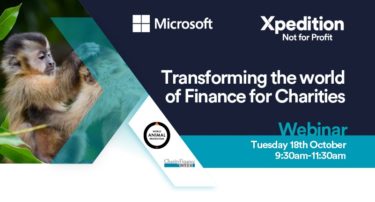How much time and resource will it take to change your charity finance software?

Steve Georgiou steps up to answer one of the biggest questions for charity organisations considering finance transformation and systems replacement
Why charities need finance software
New systems bring efficiencies and automation that can help charities to save valuable time to re-invest into the charity. Automated finance management means faster processing, more accurate reporting, less manual intervention and less firefighting. Through finance software analytics, charities can understand their impact better and identify opportunities to save money on administration.
Making do with an old system can be a mistake
No charity wants to spend for the sake of it, but charity’s do grow out of their finance software. Technology works best when it’s regularly updated. As your other systems and processes evolve, you want your finance software to keep pace. Modern cloud-based finance software includes automatic updates, so you’ll always be able to use the latest functionality, stay secure and maintain compatibility with your hardware and devices.
The functionality most charities need from their finance system
The basic functions your charity finance software will need to handle include general ledger, receivables, payables, bank reconciliation, electronic payments and purchase orders. And most importnantly you’ll need analytics and reporting capability as well as the ability to budget and forecast. If you integrate your finance system with other operational systems (fundraising, CRM and volunteer database) you’ll be able to see a complete, real-time picture of operational and financial performance.
The added pressures that charities face when investing in new finance software
Technology solution costs and dependencies are important for any organisation, but in the charity sector, there’s even greater sensitivity to questions of value and priority. Not-for-profits must be transparent about how they invest money, time and resources into back-office projects. Understanding the commitment upfront is very important.
Our charity expert has the answers to the most important questions about changing your finance system
Steve Georgiou is Xpedition’s specialist business manager for the charity sector, working every day with charities of all sizes to deliver efficiency and value through digital transformation in finance. His hands-on experience makes him the ideal expert to answer charity budget holders’ crucial questions about the real impacts of a new charity finance system project.
Q Can we keep this short? How much time and resource will a charity need to change their finance software? Give us a simple answer!
A I wish I could! But you won’t be surprised if I say that there are lots of factors that influence the time and resources needed. Every charity’s start points and needs are different. There is a good deal of work for charities to do to make a finance system project happen – there’s no getting away from that. One simple and clear point that I can make straight off: it’s unrealistic to think a finance or IT manager can supervise an optimal migration alongside their day job. You will either need to backfill an existing role, free up someone’s time or rely more on the likes of Xpedition’s resources to assist during migration.
Q What about very small charities or those with very tight budgets? Does that mean they just can’t do a finance migration?
A There’s always a way to do it, but if you can’t dedicate an in-house project manager, you may need to compromise elsewhere. If the charity is willing take a bit longer over the project and make more use of their migration partner’s resources for some aspects – testing, data mapping and so on – it can still work.
The key point is that you need to identify the resources before you start, wherever they reside, and plan realistically. It’s vital to set and manage your team’s expectations of what can be achieved in what timescale, and make sure that’s acceptable to all stakeholders.
Q How can a charity work out what resources to allocate?
A It’s all in the project planning. You need an honest conversation with your finance solution partner – be ready to share information upfront about what you want to achieve and the current state of your systems as well as the workload of your team. At Xpedition, we help our clients work out what they’ll need to provide and to set a realistic timescale, based on our experience. That way, they can gain agreement and work out how to address any challenges or resource gaps before signing off the full charity finance software project.
Q Are there any factors that clients often overlook? Can we learn from other charities’ mistakes?
A Charities can sometimes forget about key dates in their finance or organisational calendar when they’re planning. A good tip is to think about your finance workload and how it’s loaded through the month and year. If you’re busy with month end processing for five days in each period, say so. We can avoid resource-hungry activities at that time.
Not many finance teams can commit a lot of time to a finance system project at year end. Whilst it may seem like the ideal cut-off point to migrate your data across, do you really have time to focus on a crucial Go Live at that time of year? Some do, many don’t. It’s important to consider these everyday demands when coming up with a schedule and resource plan.
Q At what point will we know the exact resource need and timeframe?
A Once you’ve signed the contract, we build a detailed plan, having got to know you and your business and asked lots of questions. It’s an iterative and highly collaborative process. But there shouldn’t be any major surprises at this point, if the initial discovery work was thorough – you’ll have an indicative estimate already.
Q What happens if things don’t go to plan and take longer than predicted?
A At Xpedition, we take a very detailed approach to try and avoid surprises and hold-ups. For instance, it’s easy to put time in diaries for testing or training, which is a predictable part of the project plan, but things like a time requirement for senior managers to review project documents are more nebulous. We actively include these, even though they’re beyond the scope of a typical project plan, because we know from experience that they really can hold up the schedule.
Of course, sometimes completely unpredictable events intervene. For example, the Queen’s funeral bank holiday in September 2022. We take care not to over-promise on timescales, so it’s often possible to accelerate a little to absorb a day’s delay caused by something like this.
Q It sounds like the project management is a critical success factor
A Absolutely. Of course, you’re hiring Xpedition for our subject matter and sector expertise – but in fact, even for charities with their own dedicated PM, up to 20% of our project resources and effort will relate to end-to-end project management. The good news is that we have the highest calibre project management skills in our Xpedition team: if you need more help from us to manage your internal resources, we can flex that up.
Q Give us some specifics. How long do typical charity finance software projects take?
A Let’s consider a standard general ledger migration from one system to another, with standard requirements. That would include restructuring charts of accounts & dimension analysis, accounts payable, BACs payments and bank reconciliations and reporting – a fairly contained project. I’d say we can deliver the new solution in six to twelve weeks, depending on your resources and availability of course.
When they start looking into the finance system transformation, many charities see there’s a wider opportunity to improve efficiency and information across the organisation. So they might want to add functionality for purchase-to-pay, a staff expenses app, dashboards for a wider user community, integrations to other systems, etc. That becomes a more strategic project that’s likely to take a longer time frame. Many of our projects have been in the region of three to six months. Others have taken much longer.
Q Do charities generally realise the value they expect from their finance transformation project?
A I can only speak for our clients – yes they do. In fact, the impact can exceed expectations. For many charities, finance transformation is the lowest priority in a transformation strategy. That’s understandable, because improving and making gains for front-end operations like fund-raising are higher profile and feel more urgent when it comes to system and infrastructure investment.
But charities discover that there are great gains to be made by managing cash better at the back end, as well as transformative efficiencies from automating everyday processes. For instance, many charities with retail shops have a time-consuming manual process to move finance data from the shops to the central finance function. If you can automate this, as well as speeding up the process and improving accuracy, you free up the people who used to spend so much time doing it by hand. So there’s a double benefit: they can turn their attention to more valuable front-end activities that directly improve the charity’s delivery and fundraising capability for beneficiaries.
If you have more questions for Steve or would like to talk to him about the potential for a finance system transformation in your charity, please get in touch.
Discover our financial management solution specifically for Charities.
Other resources

How to choose the right financial management software for your charity

Crimestoppers set to digitally transform with an enhanced financial management solution

Transforming the world of Finance for Charities | On-Demand Webinar
